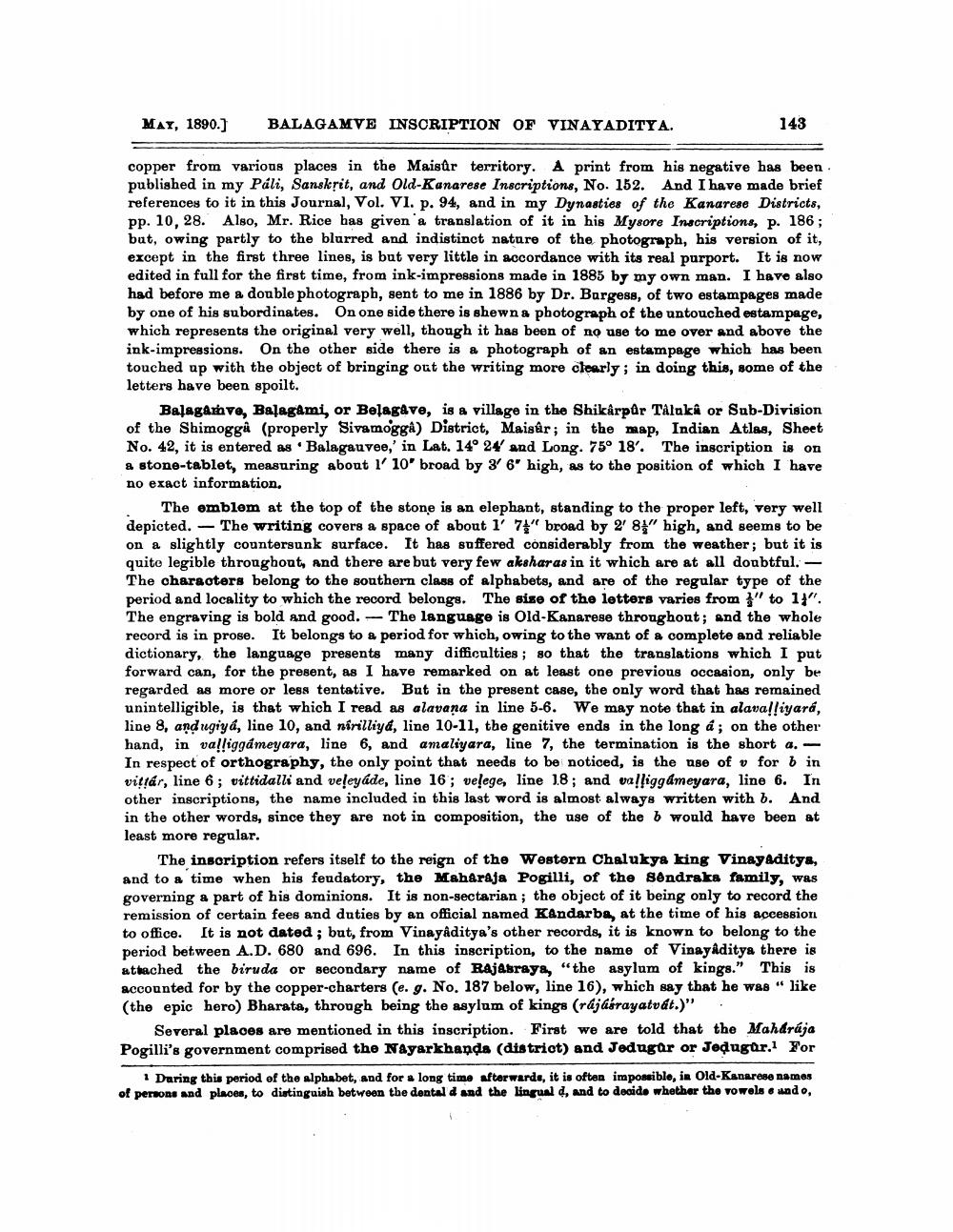________________
MAY, 1890.)
BALAGAMVE INSCRIPTION OF VINAYADITYA.
143
copper from various places in the Maisûr territory. A print from his negative has been published in my Páli, Sanskrit, and Old-Kanarese Inscriptions, No. 152. And I have made brief references to it in this Journal, Vol. VI. p. 94, and in my Dynasties of the Kanarese Districts, pp. 10, 28. Also, Mr. Rice has given a translation of it in his Mysore Inscriptions, p. 186; but, owing partly to the blurred and indistinct nature of the photograph, his version of it, except in the first three lines, is but very little in accordance with its real purport. It is now edited in full for the first time, from ink-impressions made in 1885 by my own man. I have also had before me a double photograph, sent to me in 1886 by Dr. Bargess, of two estampages made by one of his subordinates. On one side there is shewna photograph of the untouched estampage, which represents the original very well, though it has been of no use to me over and above the ink-impressions. On the other side there is a photograph of an estampage which has been touched up with the object of bringing out the writing more clearly ; in doing this, some of the letters have been spoilt.
Balagve, Balagami, or Belagave, is a village in the Shikärpar Talaka or Sub-Division of the Shimoggů (properly Sivamoggâ) District, Maisar; in the map, Indian Atlas, Sheet No. 42, it is entered as · Balagauvee,' in Lat. 14° 24 and Long. 75° 18'. The inscription is on & stone-tablet, measuring about 1' 10' broad by 3' 6' high, as to the position of which I have no exact information.
The emblem at the top of the stone is an elephant, standing to the proper left, very well depicted. - The writing covers a space of about 1' 7" broad by 2 81" high, and seems to be on a slightly countersunk surface. It has suffered considerably from the weather, but it is quite legible throughout, and there are but very few aksharas in it which are at all doubtful. - The characters belong to the southern class of alphabets, and are of the regular type of the period and locality to which the record belongs. The size of the letters varies from " to 11". The engraving is bold and good. -The language is Old-Kanarese throughout; and the whole record is in prose. It belongs to a period for which, owing to the want of a complete and reliable dictionary, the language presents many difficulties; so that the translations which I put forward can, for the present, as I have remarked on at least one previous occasion, only be regarded as more or less tentative. But in the present case, the only word that has remained unintelligible, is that which I read as alavana in line 5-6. We may note that in alava!liyará, line 8, and rgiya, line 10, and nirilliya, line 10-11, the genitive ends in the long a; on the other hand, in valliggameyara, line 6, and amaliyara, line 7, the termination is the short a. - In respect of orthography, the only point that needs to be noticed, is the use of v for b in vittár, line 6; vittidalli and veleyáde, line 16; velege, line 1.8; and valliggameyara, line 6. In other inscriptions, the name included in this last word is almost always written with b. And in the other words, since they are not in composition, the use of the 6 would have been at least more regular.
The inscription refers itself to the reign of the Western Chalukya king Vinayaditya, and to a time when his feudatory, the Maharaja Pogilli, of the Sendraka family, was governing a part of his dominions. It is non-sectarian; the object of it being only to record the remission of certain fees and duties by an official named Kandarbe, at the time of his accession to office. It is not dated; but, from Vinayaditya's other records, it is known to belong to the period between A.D. 680 and 696. In this inscription, to the name of Vinayaditya there is attached the biruda or secondary name of Rajabraya, “the asylum of kings." This is accounted for by the copper-charters (e. g. No. 187 below, line 16), which say that he was like (the epic hero) Bharata, through being the asylum of kings (rajásrayatvát.)"
Several places are mentioned in this inscription. First we are told that the Maharaja Pogilli's government comprised the Nayarkhanda (district) and Jedugar or Jedugar. For
1 Daring this period of the alphabet, and for a long time afterwarde, it is often impossible, in Old-Kanarese names of persons and places, to distinguish between the dental d and the lingual d, and to decide whether the vowels & undo,




